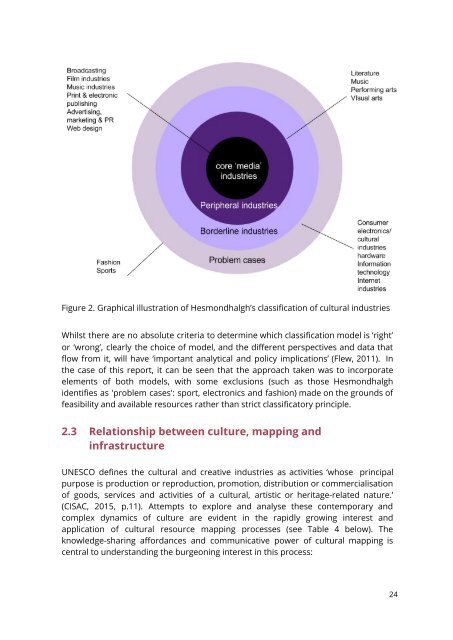- Page 2 and 3: MAPPING CULTURE venues and infrastr
- Page 4 and 5: TABLE OF CONTENTS Acknowledgements
- Page 6 and 7: L ist of Tables Table 1 Layers and
- Page 8 and 9: List of Figures Figure 1 The concen
- Page 10 and 11: NAICS NAVA NCVO SFF SHFA SIC SOC UN
- Page 12 and 13: ● A detailed case study of the Re
- Page 14 and 15: 1.2 Project phases This project ali
- Page 16 and 17: Cultural mapping has advanced signi
- Page 18 and 19: 2.1 The concept of culture 2.1.1 De
- Page 20 and 21: industries fails to recognise the d
- Page 22 and 23: Figure 1 The concentric circles mod
- Page 26 and 27: Cultural mapping enables us to unde
- Page 28 and 29: To address the breadth question, th
- Page 30 and 31: Figure 4. Culture cycle (UNESCO, 20
- Page 32 and 33: Figure 5. Six functions of the valu
- Page 34 and 35: 2.4.3 Example 3 2 CANADIAN FRAMEWOR
- Page 36 and 37: The framework is based on the conce
- Page 38 and 39: SGS Economics & Planning (2015/2016
- Page 40 and 41: in relation to those of other gover
- Page 42 and 43: Figure 8. Cultural Venues and Infra
- Page 44 and 45: Performing Art Venues ● Concert h
- Page 46 and 47: iii) Community and Participatory Sp
- Page 48 and 49: intended) use afterwards. The durat
- Page 50 and 51: 3.3 Incorporation of the value chai
- Page 52 and 53: 3.4 Application to this study (rele
- Page 54 and 55: single piece of information. The ge
- Page 56 and 57: The research team has acknowledged
- Page 58 and 59: Data Source # of venues Approach Cu
- Page 60 and 61: Data Source # of venues Approach Cu
- Page 62 and 63: Cultural industry types Count Count
- Page 64 and 65: Hills (Crown and Baptist Street Vil
- Page 66 and 67: Figure 13. Heat map of all cultural
- Page 68 and 69: venues engage in ‘production’ (
- Page 70 and 71: creation (22.3%). This finding can
- Page 72 and 73: 5.4.2 Chinatown and CBD South Villa
- Page 74 and 75:
Figure 15. Spatial categories for C
- Page 76 and 77:
Cultural space category Count Count
- Page 78 and 79:
5.4.4 A brief comparison of the thr
- Page 80 and 81:
6.2 Cultural venues by spatial type
- Page 82 and 83:
With regard to ‘practice, educati
- Page 84 and 85:
There are also 7 drama and dance th
- Page 86 and 87:
6.3 Cultural venues by value chain
- Page 88 and 89:
Table 29 shows the distribution of
- Page 90 and 91:
Figure 19. Space for ‘creation’
- Page 92 and 93:
Figure 21. Space for ‘disseminati
- Page 94 and 95:
Figure 23. Space for ‘education
- Page 96 and 97:
iii) Commercially-led developments
- Page 98 and 99:
7. MAPPING OF CULTURAL VENUES BY SE
- Page 100 and 101:
Figure 24. Venues in the music sect
- Page 102 and 103:
7.1.1 Mapping of the contemporary m
- Page 104 and 105:
7.2 Mapping of the visual art secto
- Page 106 and 107:
Table 35 shows the breakdown of the
- Page 108 and 109:
7.3 Mapping of the architecture and
- Page 110 and 111:
Figure 29. Distribution of the arch
- Page 112 and 113:
8. EVALUATION OF METHODOLOGY 8.1 Ra
- Page 114 and 115:
‘system’ or ‘ecology’ of mu
- Page 116 and 117:
its extensive coverage of all busin
- Page 118 and 119:
noticed that some participants foun
- Page 120 and 121:
● Developing further understandin
- Page 122 and 123:
of models, spanning, ‘collectives
- Page 124 and 125:
5) Sharing knowledge This priority
- Page 126 and 127:
● Identifying and examining ‘un
- Page 128 and 129:
promising areas for deepening and w
- Page 130 and 131:
City of Sydney (2012a) Creative Ind
- Page 132 and 133:
Cunningham, S. and Higgs, P. (2008)
- Page 134 and 135:
Mateos-Garcia, J. and Bakhshi, H. (
- Page 136 and 137:
Taylor, A. (13 March 2016) Carriage
- Page 138 and 139:
12. THE PROJECT TEAM Lead consultan
- Page 140 and 141:
neighbourhood of Milan. On the desi
- Page 142 and 143:
141
- Page 144 and 145:
3. Seattle Cultural Space Inventory
- Page 146 and 147:
4. Culture Map Malta Name of the ma
- Page 148 and 149:
None, it is a simple excel file upl
- Page 150 and 151:
Technology Google Maps Crowdsourcin
- Page 152 and 153:
151
- Page 154 and 155:
10. Where Creative Professionals Li
- Page 156 and 157:
Appendix 2 The full list of ANZSIC
- Page 158 and 159:
Music retailing Audio cassette reta
- Page 160 and 161:
Motion picture and video production
- Page 162 and 163:
Cable and broadcasting Cable and br
- Page 164 and 165:
Professional photographic services
- Page 166 and 167:
Museum of applied art and science M
- Page 168 and 169:
Religious organisation Bible societ
- Page 170 and 171:
Consent Do you agree to participate
- Page 172 and 173:
Have you ever been involved in cult
- Page 174 and 175:
❏ Commercial ❏ Performance or e
- Page 176 and 177:
Among the six domains of cultural a
- Page 178 and 179:
Below we ask you to specify the exa
- Page 180 and 181:
Please indicate the category of thi
- Page 182 and 183:
When in the day? (you can choose mo
- Page 184 and 185:
❏ Not- for- profit (independent)
- Page 186 and 187:
Can you tell us more about this pla
- Page 188 and 189:
World cities cultural report_3 addi
- Page 190 and 191:
Biennale of Sydney Website 29 Augus
- Page 192 and 193:
Architecture Include architecture d
- Page 194 and 195:
Colleges All public or private coll
- Page 196:
CHINATOWN RESEARCH REPORT WESTERNSY



